Whether they conform to the original definition of vertical tillage or not, more than a dozen manufacturers offer what they call vertical tillage or compact disc equipment. To supplement the report, “What is Vertical Tillage Anyway?” that appeared in the March 2014 issue of Farm Equipment, we’ve compiled the following product descriptions of “vertical tillage” tools currently available in the marketplace. The various manufacturers of the equipment supplied the information that follows.
McFarlane Manufacturing
The McFarlane SPR1000 vertical tillage seedbed conditioner is designed to do light tillage with no stratification layer whatsoever. The SPR1000 has a rank of seven-blade, 18 inch diameter spiral reels that cut residue and mix it into the soil, aiding decomposition. To produce the firm and level seedbed for optimum germination and yields, a heavy duty 3-bar harrow follows the spiral reel. The final touch for the perfect seedbed is the 12 inch diameter rolling basket that features eight, high-carbon flat bars with adjustable down pressure.
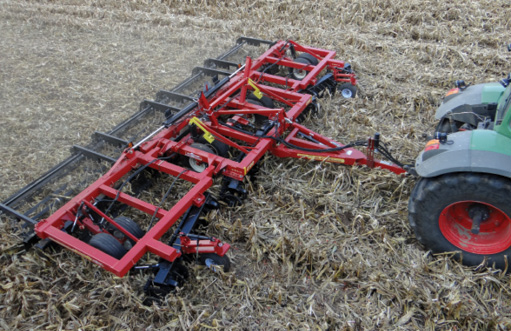
However, some customers required a machine with the option of moving more soil and creating a looser seedbed. This resulted in the invention of the Reel Disk in 2007. This machine is designed using the original features of the SPR but has added a single gang of low concavity blades with low disc angle to give the customer the option of attaining vertical tillage at the lower 5 and 7.5 degree disc angles. It still offers angle adjustment up to 13 degrees for circumstances where more leveling is needed (i.e. deep combine tracks, shallow ruts, etc.). This is unlike a standard disc which has an 18-21 degree angle on both a front and rear gang and ends up creating a stratification layer in the entire width of the machine.
The new 4100 Series Reel Disk, introduced for 2014, features a disc gang angle that can be easily changed without tools or on the go from the tractor with the addition of the optional hydraulic angle adjustment. The all-new, patent pending DURAREEL, with flow through technology provides better material flow and resists plugging in wet sticky soils. The heavy duty hub and spindle style reel bearings have a 3 piece seal design to prevent contamination.
Case IH
Case IH introduced the True-Tandem VT in 2007. The tool features an all-rotary design. Built on a disc harrow frame, two rows of ganged blades work in tandem to perform tillage and size/mix residue. Gangs are fixed at the perfect angle to avoid compaction-creating backside pressure on the blades, and an examination of newly-painted blades after several hundred acres of use clearly shows this.
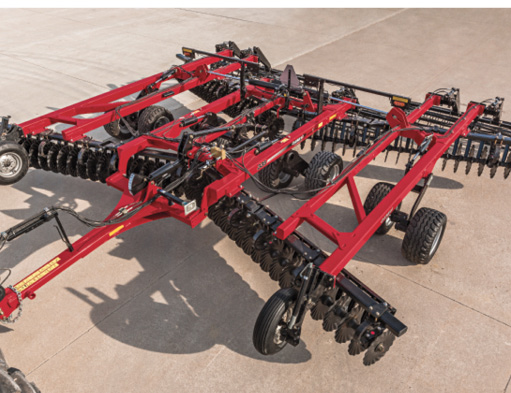
The blade has shallow-concavity with a rippled wave edge that explodes soil upward and outward. This upward and outward tossing of soil is what acts to level the soil surface, which other types of vertical tillage are unable to do. A rolling basket at the rear of the machine firms, further conditions and smooths out the soil surface. Designed to run between 7–9 mph, the Case IH VT can move through acres quickly and easily.
In the fall, immediately after harvest, the Case IH VT slices tough Bt residues and corn rootballs, and gives the residue contact with the soil to start the process of breaking down the residue to release nutrients into the soil. The unit levels out wheel tracks and is an excellent way to incorporate lime and fertilizer.
In the spring, the Case IH VT prepares the seedbed by leveling the surface and uprooting weeds. The blade action removes crusts and shallow compaction, all of which make for a seedbed that allows uniform and earlier germination, as well as less planter bounce.
Case IH design begins with the agronomics of optimum preparation for plant growth with the goal of maximizing yield potential. And the Case IH VT machine is truly a versatile tool that has the potential to make an agronomic impact throughout most North American grain farms.
In the case of the Case IH vertical tillage tool, it has proven itself over 8 years of weather patterns; fall and spring; and a very wide geography. Case IH agronomic researchers have logged several million data points over 10 years with various tillage practices including the True-Tandem VT. This is a proven unit that enhances yield potential; farmer efficiency; and provides rugged durability in the field.
Thurston Manufacturing
Depending on the main objective of the operation, BLU-JET builds a variety of tools that can meet farmers’ needs. SubTiller 4, for example, has StalkSizer coulter attachments and baskets or a conservation roller to eliminate deep compaction layers within the soil, size residue and perform a leveling operation.
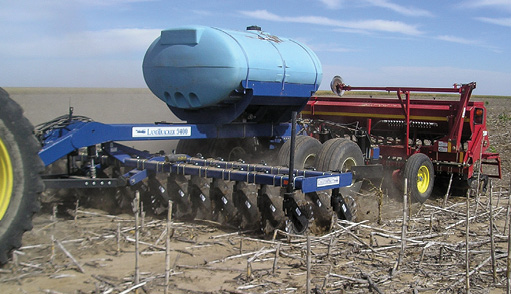
BLU-JET CoulterPro, when combined with the LandTracker 9400 Implement Caddy, can allow the producer to size residue and apply liquid fertilizer in a combination pass with a 3-point planter or no-till drill. This same CoulterPro and LandTracker combination can be used in a one-pass operation with SubTiller for residue sizing, deep compaction elimination, dry fertilizer banding and leveling.
EarthMaster
The new 3000 Series vertical tillage tools from EarthMaster uses low concavity SoilRazor blades to cut and capture residue. The SoilRazor blades, with their saw tooth profile and cutting edge on the side of the blade stay sharp longer, providing better residue sizing over more acres. The gangs of blades are mounted at 18 degrees causing just enough dirt movement to pull up rootballs and to mix the cut residue with soil, capturing it on the surface. The effects of the capturing action are that the residue decomposition is aided by the soil’s anaerobic characteristics, getting the plant nutrients back into the ground; the combined mixture of soil and residue has enough stability to reduce wind or water erosion in the field during the winter months.
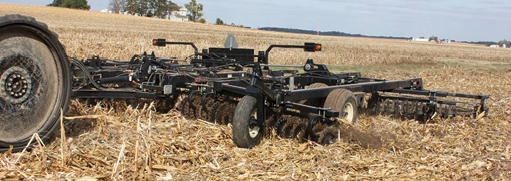
Finally, the large diameter rolling baskets provide a tamping action, helping to pin the residue to the ground while also leaving a level surface behind the machine. In the spring, the SoilRazor blades cut through the remaining residue and breaks up the winter surface compaction while cleaning up any spring weeds before planting. The result is a level seedbed with soil that has been “fluffed” enough to dry and warm quickly, letting the planting operation start sooner.
From the customer’s standpoint, the EarthMaster 3000 is easy to set up, easy to adjust and easy to operate, making the process of getting the job done as simple as possible.
Kuhn Krause
The Kuhn Krause Excelerator Vertical Tillage System accomplishes the agronomic definition of vertical tillage by managing high volumes of residue, creating an ideal seedbed and not producing a horizontal layer in the soil profile. The Excalibur Blade uses its aggressive serrated edge to slice tough residue, penetrating the soil 1.5-3 inches deep. The 32-flute shallow concavity blade produces small clod size and provides just enough lateral soil movement to mix residue and begin the soil leveling function. The blade concavity measures no more than 0.25 inches and is limited to the fluted area of the blade.
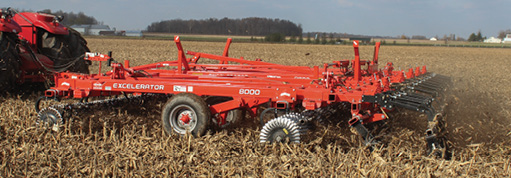
Two rows of Excalibur Blades are on an adjustable angle from 1-5 degrees, which allows the operator to determine the amount of soil and residue mixing for the given field situation. The combination of shallow blade concavity and minimum degree of gang angle allows the blades to stay sharp through their operational life. Hydraulic wing pressure from the tractor ensures consistent depth of operation across the width of the machine and eliminates wing bounce at high speeds.
The industry exclusive Star Wheel Treader then downsizes clods, levels the soil and anchors residue in the soil, deterring wind and water erosion of both soil and residue. Pressure is also applied to the Star Wheel Treaders to maintain continuous soil contact. The last step in the process involves the 24/7 Conditioning Reel, which further conditions and prepares the seedbed providing a superior planting environment for the seed.
HCC Inc.
The SMART-TILL was introduced 8 years ago. It is a tool that can be used in the spring as well as in the fall. In the spring, the tines fracture the soil more than 8 inches deep with little surface disturbance. This creates improved air and water exchange, which offers many benefits and allows a farmer to get into the field sooner to plant.
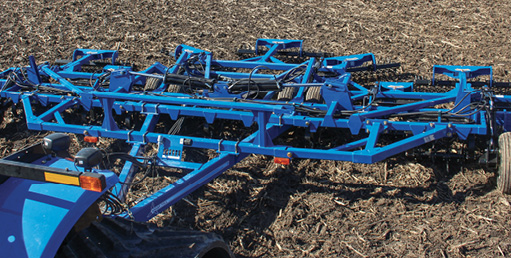
In the fall the SMART-TILL is used for residue management. The tines fracture the soil and break up corn stalks and other residue. SMART-TILLing the field in the fall helps break down the stalks and holds moisture. In addition, the rotary harrows reduce the opportunity for the stalks or other residue to blow away during windy winter conditions.
The optional rotary harrows can be varied up to 30 degrees in either direction. This variability creates different amounts of loosened soil, the adaptability also sets the depth of penetration for the rotary harrows allowing for changes according to field conditions and crops, which ultimately increases the potential to optimize the field’s finish.
Salford Group
Salford’s high clearance vertical tillage machines are industry leaders in preparing superior seedbeds at high speeds in a greater range of soil moisture and residue conditions. Like other true vertical tillage implements, Salford uses wavy coulters that enter straight into the ground. By putting wavy blades straight into the ground Salford vertical tillage tools remove compaction layers in the seedbed even when running in damp soil. The wavy blades, mounted on 5 or 7.5 inch spacing, lift some soil on top of the residue, which speeds up soil warming and residue decomposition.
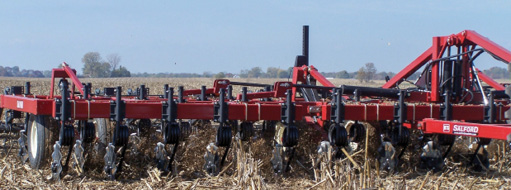
Salford’s vertical tillage implements use unique patented independently mounted blades staggered throughout a deep frame. Unlike tools with disc gangs, the independent blade mounts spread the working pressure of the machine more evenly under the entire frame. This allows for maximum clearance, residue flow and obstacle protection.
The reset pressure of the independently mounted blades also creates vibrations that loosen the soil density below the working depth. This allows Salford vertical tillage tools to further reduce soil density without completely destroying structure of the soil. By maintaining overall soil structure, fields prepared with Salford vertical tillage tools are less prone to rutting.
New generations of Salford vertical tillage tools are also capable of carrying shanks on 15, 20 or 30 inch spacing for deeper soil density reduction and precision tillage. The 1,300 pound hydraulic shanks run up to 8 inches deep and can be engaged and disengaged from the tractor seat. This allows the operator to go from surface vertical tillage to deeper vertical soil density reduction in a matter of seconds.
Summers Manufacturing
Early seeded crops benefit when wet low-lying field areas aren’t “mudded in.” Shallow seeded crops thrive in the uniform seedbed that true vertical tillage provides. Moisture management is also improved with vertical tillage. Providing a path for moisture to enter the soil where it lands allows hilltops to absorb heavy rain downpours that increase hilltop yields while helping to eliminate washing and drowning out of lowlands.
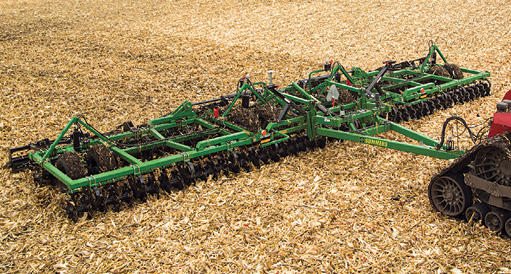
Straight blades provide the best cutting properties, but don’t move much soil. The 5/8 inch pitch 20 wave turbo coulter blades move a little more soil without sacrificing much cutting capability. The 1.25 inch pitch 13 wave 22 inch diameter coulter blades emphasize soil movement over cutting properties. 1.75 inch pitch 8 wave 20 inch diameter blades aggressively move soil and concentrate cutting pressure for conditions that require soil movement along with cutting capabilites. The 8 wave notched blades are the most aggressive with superior cutting as the notch enters the soil and a scoop action when the notch exits the soil. The patented hydraulic hitch allows the operator to adjust the emphasis from front to rear gangs for varying field conditions. Gang mounting of the blades ensures uniform operating depth that is immediately apparent when used ahead of shallow seeded crops.
Growers needing to convert wet, saturated soils into an acceptable seedbed inspired Summers Mfg. to develop the patent-pending internal scraper for the rolling basket finishing attachment. This feature allows the mixing and leveling features of the rolling baskets to be used continually in even the wettest field conditions.
Great Plains
The In-line subsoiler and Turbo-Chisel are fall, deep tillage tools that will “reset” and maintain uniform soil density. The In-line subsoiler buries no residue and leaves the surface undisturbed. The Turbo-Chisel is designed to size residue, loosen all root balls, never move soil sideways, bury 60% of the residue and leave the surface smooth enough to “one pass” in the spring.
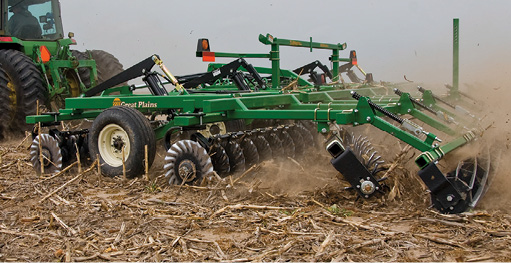
Great Plains offers 3 vertical finish tools. Turbo-Till, Turbo-Chopper and Turbo-Max. Vertical finish tools must do 3 things:
- Maintain uniform density;
- Size residue; and
- Provide a “perfect” seedbed for the planter.
Turbo-Till is loved by no-tillers because, while it is a perfect residue manager, it buries no residue. Turbo-Chopper is well liked by the corn-on-corn operation where heavier fall tillage is done with a Turbo-Chisel and then with one pass of the Turbo-Chopper, a “perfect” seedbed is created 2 inches deep at planting depth for a smooth planter ride and precise, consistent seed placement. Turbo-Max is a great tool for the min-tiller. One aggressive pass in the fall and a second spring pass with turbos running straight for a uniform, “true vertical” finish.
Environmental Tillage Systems
Environmental Tillage Systems SoilWarrior brand of vertical tillage surgically incorporates fertilizer while building a moisture-correct seedbed utilizing the patented Cog Wheel for deep tillage in the fall and the XS attachment in the spring. The SoilWarrior X row unit features high psi air spring downforce with parallel linkage ensuring that each row maintains a consistent depth. The 30 inch Cog Wheel has 20 inches of travel to roll up and over obstacles like rocks.
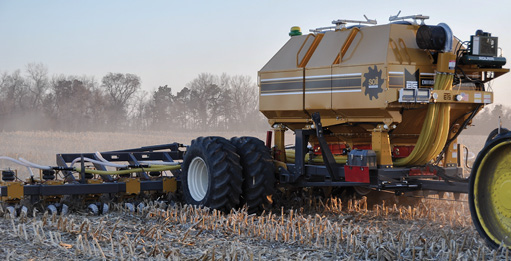
The ETS SoilWarrior provides the same benefits of no-till farming while providing the necessary tillage and access to incorporated fertilizer to maximize the genetic potential of the seed. ETS’s heavy duty complete environmental friendly systems set the standard for in-field performance, machine durability and ease of operation.
SoilWarrior’s Zone Tillage keeps soil where it belongs — in the field. It does this by maintaining the root structure between each tilled zone and incorporates residue into the growing zone. The SoilWarrior cuts and sizes residue, loosens and tills the soil and creates an erosion-resistant zone while building up more organic matter that increases soil health and moisture retention. Those who embrace Zone Tillage today are actively helping revitalize and rebuild their land.
Landoll Corp.
Vertical tillage is a process. The tools that could be used in the fall for resetting the soil density would be our Zone Commander/In-line Ripper, Coulter Chisel, Ripoll and Weatherproofer. If a producer’s soil density is in good shape, our VT-Plus can be used to size and anchor residue. For seedbed preparation or spring tillage, the Landoll VT plus would be the tool of choice. The Landoll VT plus utilizes an ultra-shallow concavity 22 inch diameter blade on 7 inch spacing. The gangs are on a pre-determined angle that provides the proper amount of mixing of soil and residue. Gangs that are on a lesser degree of angle will not provide enough movement of soil for leveling of ruts or tire tracks left from the previous harvest or spraying operation. Lateral movement of soil is imperative in anchoring residue so that it is not susceptible to erosion from wind and water.
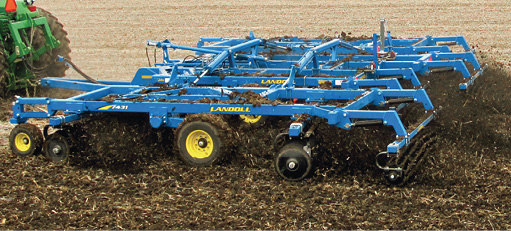
Kongskilde Industries
The Kongskilde 9100 Vertical Tillage Machine is available in 3 sizes: 15, 25 and 32 feet wide. The Kongskilde unit has 5 different gang angle adjustments from 0-16 degrees front and back, which allows it to achieve working depths from 1-6 inches. This allows the unit to do primary and secondary tillage with one machine, which is unique in the vertical tillage industry. It utilizes 20 inch diameter self sharpening saw tooth VT razor blades that have a 1.5 inch concavity.

The Kongskilde machine is one of the heaviest units in the market today, as it utilizes 0.5 inch thick, 6 inch x 6 inch square tubing for the main frame front to back. These main frames are laser cut to allow the 4 x 6 inches cross members to pass through and then are welded for greater strength. This creates a very heavy unit that aids in good penetration in all soil types.
The VT blade gangs are mounted to the angle adjustment tubes with a heavy duty C style cushion spring (rock flex). Kongskilde uses 12.5L x 16-14 ply galaxy tires on the main frame and 11L x 15-12 ply galaxy tires on the wings. These tires are a heavy duty flatter tread than rib implement tires. This provides better flotation characteristics and much better stubble wear than rib implement tires. Kongskilde uses a single point hydraulic depth control to regulate the working depth, and heavy duty tandem axles on the base and wings. The tandems on the wings are farther forward than the main tandems that give good stability to the wing which is very beneficial when working on uneven ground at high speeds.
Kongskilde uses a 14 inch diameter heavy duty adjustable spring loaded roller harrow on the rear of the unit, which aids in breaking clods and leaving a firm and level seed bed. In many cases, we are saving farmers one pass over their acreage per year. This is a huge cost and time savings of $20 per acre.
Lemken USA
Lemken USA does not classify the 3 different models of Lemken compact discs as vertical tillage. The Lemken equipment features low concavity notched blades always mounted on their own individual arm, not on a gang, and does not have 2 blades mounted to 1 arm. The 3 models available — Heliodor 18 foot, Rubin 9-24.5 foot and Rubin 12-29 foot — feature notched blades. Depending on the working depth desired and how much residue the farmer wants buried, he can choose the right unit for individual conditions.

The Heliodor with 18 inch blades will work from 1-4 inches, the Rubin 9 with 24.5 inch blades from 1-5 inches and the Rubin 12 with 29 inch blades can work up to 8 inches deep. All three units are designed to operate at 8-12 mph and will leave a very smooth finish. The individual arm allows the disc blades to be run at a dual angle being angled from parallel to the direction of travel (16.5 degrees on the Heliodor, 17 front and 15 rear on the Rubin 9 and 16 degrees on the Rubin 12; and also angled from vertical — 10.5 degrees Heliodor, 20 degrees Rubin 9 and 20 degrees Rubin 12) to the entry of the ground. The result of the dual angle is that working depth of the entire soil profile is worked at 3 inches or greater. On a VT type of tool, the soil typically is not all worked and below the loose soil at the surface there are unworked strips which will leave a rougher finish for planting even though it may look smooth on top and also will not unroot the residue from the harvested crop or weeds.
Compact discs are similar to VT only in the aspect of the high field operating speed. With a compact disc the machine is sizing residue and burying it where a VT tool will size the residue and bring some dirt to the surface to mix with it but the dirt and residue are primarily left at the surface with a high percentage of the residue left exposed or unburied.
The Lemken Rubin Compact Disc features 24 inch blades mounted on individual arms with coil spring rebound control. The discs are aggressively configured with a unique dual angle to both the direction of travel and the entry point to the ground. This configuration achieves intensive soil movement and residue sizing, burying 60% or more of the residue while leaving a smooth finish. Operating speeds of 8-12 mph and working widths from 8 feet to 40 feet make the Rubin a high performance high productivity machine.
Horsch
The Horsch minimum-till residue management tool is called the Joker. It is not vertical tillage, nor is it traditional tillage. The Joker is in a category of its own. It features proven technology based on scientific principles to break down residue while conserving moisture and preventing erosion. After experiencing success in other markets around the world, the technology has been redesigned specifically for the North American market. This machine offers a true residue management process:
Residue Sizing: Offset notched blades with an overall spacing of 5 inches slice through crop residue to effectively size it. The fast rotation of the blades make for an aggressive chopping action, as well as effective soil penetration.
Residue Blending: The high speed rotation of the serrated blades turns the soil while chopping residue. This results in an ideal mixture of tilled soil with properly sized residue, speeding the decomposition process.
Oxygen Introduction/Warming: As the soil and residue are mixed, oxygen enters the tilled zone. In cooler soils, the action also warms the seed zone for rapid emergence of seed.
Activation of Soil Bacteria: Machinery doesn’t break down residue, soil bacteria does. When soil is warmed and oxygen is introduced, soil bacteria become active and feed on crop residue. During this process, the residue decomposes, and the nutrients become available for new plantings.
Consolidation and Leveling: Consolidating the soil/residue mix helps bacteria break down residue better. The consolidated and level surface also produces an ideal seedbed, prevents erosion and creates a capillary effect to preserve moisture.

We have also made an effort to improve the farmer’s bottom line through a reduction in maintenance items. Our rubber torsion system, sealed oil bath bearings and roll-flex consolidation system all provide thorough work at high speeds without high maintenance costs.
Amazone
Catros equipment is very different from all U.S. manufactured vertical tillage machines. It is designed with two parallel beams where the discs are mounted. These discs are mounted in opposing angels between the first and second beam. If you were to view the Amazone Catros from above, you would see the “=” sign, instead of the letter “X” that is typical with U.S. equipment. This is why the European machines are often called “short discs” or “compact discs.” There is a very short distance between the absolute front and rear of this machine. When you work from a straight frame and mount the discs at an angel, a gang bolt cannot be used, which increases the openness of the machine. The Catros has an open space between each disc that reduces the chance of plugging. Of course, when there is no gang bolt, a hub with a bearing is mounted on each disc, and this combo is hung from the upper frame. Amazone hubs are filled with synthetic oil, similar to the bearings used in military style track rollers. Space age seals complete the system.
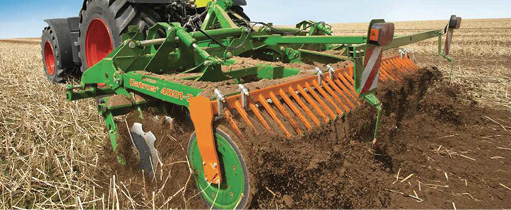
Since every disc is independently mounted from the disc next to it, this allows for the installation of rubber torsion bars onto each disc arm. The discs move independently of each other creating ideal end result. The weight of the machine is equally divided over each of the discs. As a result, each disc penetrates the ground at an even depth following any ground undulation. Amazone discs are concave, which facilitates turning of the ground. The two rows of discs are followed by a wedge ring roller, which rolls the ground and creates a firm residue/seed/weed contact. When operated in the proper manner, the Catros will cover 80% of the residue with some dirt, but it can set in such a way that only 30% is covered, depending on the farmer’s needs. If this machine is used in the manner it was designed, there is no other tool on the market that creates a more even finished result. Furrows, tracks from pivots or machines all disappear in a few passes.
We believe there should be open space between each disc and an adjustment between the two rows so that when the discs are wearing down the perfect point of impact can be maintained. Other manufacturers work with the old disc harrow/gang bolt design, which does not precisely follow the ground contour. There are a number of manufacturers who think all they have to do is just cut residue to size, while others have decided to improve the quality of the machines by turning the ground and mixing the cut residue with the ground to shorten the time of decay. In Europe farmers decided that they wanted a true one-pass seedbed preparation tool/vertical disc. Using a concave disc design in preset angels on the two frame beams at 10–12 mph would create an end result where the residue is cut, leveling and mixing the top 2-4 inches of soil with residue, manure or fertilizer depending on how you set your operating depth and roll it down so decay and germination can start immediately. The closer the harvesting machine is followed, the more moisture is still available so germination and decay can start immediately. Then cover crop seeders were added to this machine to perform yet another job in the same pass, making this machine a true “one-pass” implement.
Maschio
Maschio designed a complete range of speed discs called UFO. This is a multi-dimensional, one-pass tillage implement to accomplish several actions in the field (e.g., residue sizing and blending, soil bacteria activation, finishing). The 24-inch discs of the UFO allow it to operate much faster than the traditional tillage tools. In fact, it works best at speeds from 8-12 mph, leading to significant fuel and time savings.
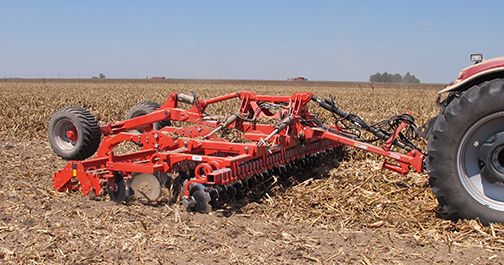
The UFO starts with two rows of offset, notched 24-inch discs and double coil spring arms are incorporated where the disc gangs are attached to the implement frame. These double coil spring arms are maintenance-free and damage resistant. They allow the discs to harmlessly float over rocks and other foreign objects, and they maximize trash flow through the unit. Moreover they make a 3D vibration (upward, downward and sideward) that increases residue sizing and blending. The farmer then has the option of putting a tandem basket roller in the back or packer, rubber and ring rollers.
Other features of the UFO include maintenance-free disc hubs with metal face sealing, double bearing and oil filled, thus providing long service life (20,000 acres warranty). Discs are mounted directly to the bearing caps, which helps protect the bearing from damage in the field. Adjustable side discs are located at the out ends of each of the notched disc rows. These special discs prevent ridging and ensure level conditions. The mounted UFO series comes in widths ranging from 8- 13 feet and the pull-type series is available in 13-20 foot units.
AGCO
The Sunflower 6631 Vertical Tillage tool is a second generation vertical tillage tool. Not a second generation of a Sunflower design but in the second generation of the genre. The first generation tools were defined by their lack of or very little gang angle. These tools sliced the crop residue and exposed some soil to the sun providing the desired early entry into the field but the crop residue was laying loosely on the soil surface and prone to wind and water erosion. This caused considerable problems of which loose residue migrating over newly planted seeds was one causing the most concern. Producers expressing the need to anchor crop residue into the soil led to the next evolution. The second generation vertical tillage tools utilize a combination of gang angle and low concavity blades to move sufficient soil to properly anchor the crop residue to prevent its migration.

The 6631 is designed for surface tillage and residue control. The high performing Saber Blade is exclusive to Sunflower, and is one of the most exciting tillage innovations in years. This unique combination of low concavity, 25 perfectly sized flutes and the serrated “saw tooth” edge works the soil like no standard blade can. The blade is extremely well suited for cutting through the toughest of residue, penetrating the soil and eradicating weeds. The Sunflower Saber has excellent clod-crushing capabilities at normal working speeds and yields excellent performance in soft soils. As the cutting edge wears, it actually maintains an aggressive cutting edge. The Sunflower Saber Blade continues to work season after season, cutting heavy residue long after standard blades have dulled beyond effectiveness.
Quivogne
The Diskator from QNA is designed and engineered to be the best multi-season, multi-use tillage tool. Equipped with 22 inch discs and the heaviest duty roller in the market, it performs high-speed stubble cultivation so organic matter decomposes faster, soil erosion is reduced, and the ground is smoothly prepped for seeding. It is available in fixed versions or 9 and 12 feet as well as folding versions of 12-40 feet, with a transport width of only 10 feet wide. Its unique benefits include sizing residue and mixing it with soil to hold it in place for optimum planting conditions.








